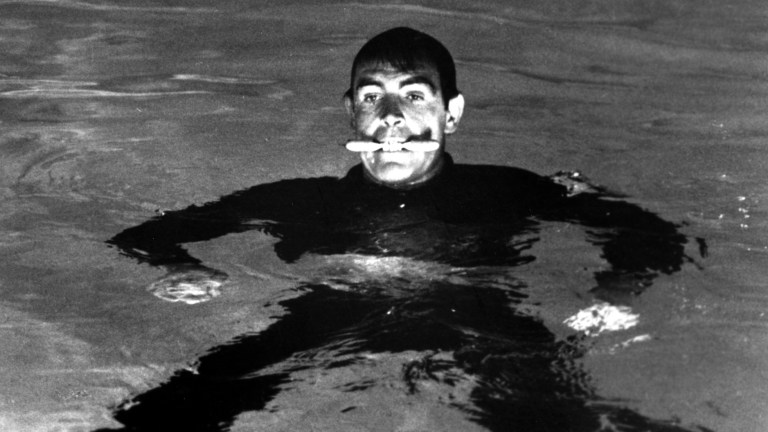James Bond: Everything Right and Wrong About 007 Is in Thunderball
The James Bond franchise reached new heights in popularity with 1965's Thunderball, but it's also an example of some of 007's worst tendencies.

The biggest, most audacious James Bond movie during Sean Connery’s celebrated run as the British superspy is 1965’s Thunderball, a spectacular adaptation of the Ian Fleming novel of the same name. Thunderball sees the insidious terrorist syndicate SPECTRE steal two nuclear warheads from NATO and hold the world governments hostage for £100 million. After a run-in with SPECTRE operatives at a local clinic while recuperating from a recent mission, Bond suspects the warheads are hidden in the Bahamas and convinces M to investigate further. Upon arriving, Bond matches wits with high-ranking SPECTRE figure Emilio Largo (Adolfo Celi) and assassin Fiona Volpe (Luciana Paluzzi), romancing Largo’s girlfriend Domino (Claudine Auger) as he searches for the warheads.
Nearly 60 years after its initial release, Thunderball remains the highest-earning Bond film in North America after adjusting for inflation and is the second in the long-running series to win an Academy Award for Best Visual Effects. The film represents James Bond at the height of the franchise’s cultural relevance and ubiquity, and yet it also contains examples of the series’ worst tendencies, which to this day cast a shadow over the film and series as a whole.
Widescreen 007
It’s immediately striking how much more cinematic in scope the movie feels, particularly compared to the three preceding Bond films. Thunderball was the first James Bond movie filmed natively in a widescreen format, using Panavision cameras and the same anamorphic aspect ratio and film quality as big event films like Lawrence of Arabia and West Side Story. Thunderball trades heavily on spectacle and lives up to its tagline as “the biggest Bond of them all.”
Director Terence Young’s big action set pieces take advantage of the widescreen format too, beginning right in the film’s prologue. There Bond battles a SPECTRE associate in a picturesque chateau before escaping on a jetpack, a sequence among Connery’s best Bond openings. This immersive presentation carries over to quiet scenes like the MI6 briefing and sweeping shots of the beautiful scenery in the Bahamas, both above and below water. Gone are the more claustrophobic shots and action sequences from the first three movies in favor of something that truly feels like a cinematic event.
The Connery Effect
Thunderball marks Connery’s fourth performance as Bond and his third collaboration with Young, who previously directed Connery in Dr. No and From Russia With Love. There’s a playfulness to Connery this time around. He practically glides through every scene with a wink and well-timed quip while making everything look so effortless. He’s also arguably in the best physical shape he ever possessed while playing the role.
Connery has always managed an effective balance between suave and rough-and-tumble as Bond, but in Thunderball, he’s just so unquestionably cool and visibly comfortable in the role. It’s the character in top form. Thunderball also feels like the last time Connery is truly invested in his own performance as Bond, despite reprising the role in three additional films, including the unofficial Never Say Never Again. Connery is having a blast making Thunderball and that enthusiasm spreads to the audience, even in the movie’s slower moments—and believe me, this movie has plenty of them.
That charisma radiates off Thunderball and sets it apart from the countless Bond pastiches popping up across the ‘60s. Still, by 1967’s You Only Live Twice, Connery found himself drifting away from the role that made him an international icon, clearly affecting his performance.
Treading Water
Before Thunderball, every James Bond movie had been less than two hours. Thunderball is the first in the franchise to exceed this runtime, clocking in at 130 minutes. By the ‘70s, this runtime had become the norm for the series, for better and worse. This isn’t to say that long Bond movies aren’t good ones—On Her Majesty’s Secret Service and Skyfall, are among the longest—but Bond pictures do tend to generally struggle with their pacing, often padding out the runtime rather than advancing the plot or to create some distance until the next major set piece.
Thunderball‘s filmmakers are is too enamored with the novelty of showcasing how beautifully it can film extended sequences underwater. In the movie’s defense, the crystal blue Bahamian waters are impressively captured, made all the more expansive by the film’s widescreen format, highlighted best in a rousing battle between U.S. Navy frogmen and SPECTRE divers on the ocean floor. The problem is Thunderball keeps bringing the audience underwater and the novelty wears off before even the first aquatic sequence concludes, with each subsequent underwater scene feeling more unnecessary and slow-moving than the last. What was probably a groundbreaking novelty in 1965 just grinds the movie to a halt to modern eyes.
The Sexist, Misogynist Dinosaur
The most troubling single element in Thunderball occurs relatively early in the film as Bond recovers at a clinic in the English countryside. After barely surviving being tortured on a stretching machine by SPECTRE agent Count Lippe (Guy Doleman), Bond coerces the attending physical therapist Patricia Fearing (Molly Peters) into hooking up with him in exchange for him not telling anyone about the incident. The scene isn’t as disturbing as Bond forcing himself on the absurdly named Pussy Galore (Honor Blackman) in the preceding film, Goldfinger, but still serves as a strong reminder of the character’s misogynistic foundations.
Even compared to Goldfinger, there is something particularly unsettling about how the Thunderball scene, with Bond manipulating Fearing into a sexual encounter under threat of losing her job, going as far as to physically corner her against the wall of a sauna before they strip. No Time to Die filmmaker Cary Joji Fukunaga compared Bond’s actions in Goldfinger and Thunderball to rape and Fukunaga’s observation is not an exaggerated or sensationalized one. There are definite issues regarding sexual consent in this specific sequence in Thunderball, and they severely tarnish the film and franchise’s legacy.
One can dismiss Bond as being a product of a more overtly chauvinistic time, and that much is true, but the scene between Bond and Fearing takes this writer out of the movie every time. Because of his line of work and who he is, Bond does morally questionable stuff all the time, but incidents like this feel too far, especially for a popcorn action movie presumably geared to wider audiences. The scene, unfortunately, reflects the concerning sexual politics at the time, as also evidenced in contemporary counterparts like 1966’s Alfie or 1968’s Candy.
To the Bond franchise’s credit, later takes have explicitly called out and confronted the darker parts of its legacy. Timothy Dalton’s Bond was much less sexually active onscreen than his predecessors while Pierce Brosnan’s Bond is referred to a “sexual, misogynist dinosaur” and “a relic from the Cold War” by his superior in 1995’s GoldenEye. There are still boorish tendencies in the latter films in the series, but they are accompanied by a sense of self-awareness that Thunderball blatantly lacked in 1965.
Thunderball marked James Bond hitting a new peak of cultural relevance and worldwide recognition. Everything that showcased why Connery was perfect for the role and why 007 was king of the spy genre is beautifully rendered and encapsulated here. Thunderball will always occupy a special place in Bond history, but it does come with some heavy caveats.
